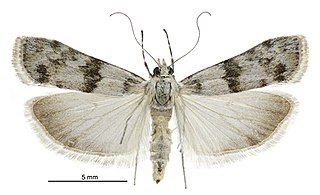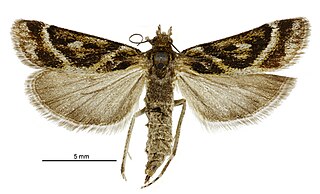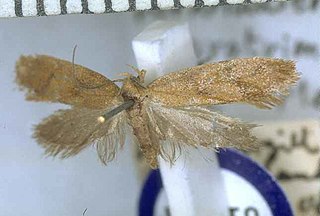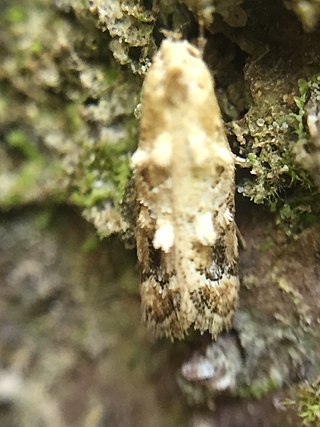
Heterocrossa contactella is a species of moth in the family Carposinidae. It is endemic to New Zealand and can be observed in both the North and South Islands. The preferred habitat of this species is native forest and scrub, especially where Leptospermum shrubs are found. Adults are on the wing in December and January.

Amblyptilia epotis is a moth of the family Pterophoridae. It is endemic to New Zealand and is found in the South and Stewart Islands. It inhabits mountainous terrain covered in alpine vegetation or alternatively alpine wetland habitat. The adults of this species are on the wing from February to March. In appearance the adults of this species are variable in colour however this species can be distinguished from similar species by the oblique apical streak on its forewings as well as the patch of white on the costa cilia towards the apex of the forewing.

Mnesarchaea paracosma is a species of primitive moths in the family Mnesarchaeidae. It is endemic to New Zealand and can be found in the Kaikōura, mid and south Canterbury, MacKenzie, Otago Lakes, Central Otago, Dunedin, Fiordland and Southland areas. M. paracosma lives in a wide variety of habitats including tussock grasslands, shrubland, and damp native beech or podocarp forests, at a range of altitudes from around sea-level up to 1200 m. Adults of this species are on the wing from October to February and are day flying, although they are attracted to light at night.

Eudonia asaleuta is a moth of the family Crambidae. It was described by Edward Meyrick in 1907. It is endemic to New Zealand and has been collected in the South Island in the West Coast, Fiordland,Canterbury, Otago and Southland regions. This species inhabits bare shingle areas as well as tussock habitat with few trees or scrub at altitudes of under 1000 m. Adults are on the wing from November to February.

Pyrgotis eudorana is a species of moth of the family Tortricidae. It is endemic in New Zealand and has been observed in both the North and South Islands. However it is regarded as a rare insect. This species inhabits native forest. Larvae exclusively feed on Muehlenbeckia australis and adults are on the wing from November to April. Adults are attracted to light.

Eudonia xysmatias is a moth in the family Crambidae. It was first described by Edward Meyrick in 1907. This species is endemic to New Zealand and has been observed and collected in Otago. This species inhabits wetlands. Adults are day flying and are on the wing in December and January.

Scythris niphozela is a species of moth in the family Scythrididae. It is endemic to New Zealand. It is regarded as being endemic to the Kaitorete Spit area although previously it had been recorded in the Manorburn Ecological District. This species inhabits the foredune area of Kaitorete Spit. The larvae feed on Carmichaelia appressa. Adults are day flying and are on the wing from October to December. These moths are not attracted to light. The species are classified as "At Risk, Naturally Uncommon" by the Department of Conservation.

Asaphodes dionysias is a species of moth in the family Geometridae. This species is endemic to New Zealand and is only known from mountainous areas in Central Otago. It lives in open grassy mountainous habitat at altitudes up to 1750 m. It is also known to live in wetland habitat. The larvae of this species feed on native herbs. The adults of this species are on the wing in January and February. The adult female of the species has reduced wing size in comparison to the male.

Tingena apanthes is a species of moth in the family Oecophoridae. It is endemic to New Zealand and found on the North Island. The adults are on the wing from October to December. It appears associated with Leptospermum species and it has been hypothesised that the appearance of the adults of this species imitates faded Leptospermum leaves.

Tingena aphrontis is a species of moth in the family Oecophoridae. It is endemic to New Zealand and has been collected at altitudes between 3000 - 5000 ft at Arthur's Pass and Mount Arthur. The species lives in open alpine habitat amongst alpine vegetation. Adults of the species are on the wing in January.

Tingena berenice is a species of moth in the family Oecophoridae. It is endemic to New Zealand and has been found in the North and South Islands. It is a brightly coloured species which is on the wing in November. Its preferred habitat is mixed beech forest.

Tingena crotala is a species of moth in the family Oecophoridae. It is endemic to New Zealand and is found both in the North and South Islands. This species inhabits native forest and is on the wing in November and December.

Tingena eriphaea is a species of moth in the family Oecophoridae. It is endemic to New Zealand and has been found in Otago. This species is known to inhabit native beech forest.

Tingena idiogama is a species of moth in the family Oecophoridae. It is endemic to New Zealand and has been observed on the slopes of Mount Taranaki. Its preferred habitat is native subalpine scrub and adults are on the wing in January.

Tingena paratrimma is a species of moth in the family Oecophoridae. It is endemic to New Zealand and has been observed in the lower parts of the South Island. George Hudson regarded this species are uncommon. The adults of this species are on the wing from November to February.

Asaphodes nephelias is a moth in the family Geometridae. It is endemic to New Zealand and has been observed in the South Island. The preferred habitat of this species is alpine tussock grasslands above native forest and in wetlands. The adults of this species are on the wing from January to March and are day flying. The female has brachypterous wings.

Asaphodes prymnaea is a moth in the family Geometridae. It is endemic to New Zealand and can be found on the Mount Arthur tableland. It is common in limestone valleys. The female of the species is paler and has less distinctive markings than the male. Adults are on the wing in January and February.

Asaphodes sericodes is a moth in the family Geometridae. It is endemic to New Zealand and has been observed in the southern parts of the South Island. This species inhabits open tussock grasslands in subalpine scrub or wetlands. The female of the species is likely semi-apterous and is flightless. The adult males are on the wing in January.

Trachypepla aspidephora is a species of moth in the family Oecophoridae. It is endemic to New Zealand and has been observed in the North and South Islands. Adults are on the wing from November to March and are attracted to light. The moths can be found resting on tree trunks where their colouration imitates lichens.

Scythris epistrota is a species of moth in the family Scythrididae first described by Edward Meyrick in 1889. It is endemic to New Zealand and has been observed in the South Island. The larvae have been found on species of New Zealand broom and they pupate within an irregularly shaped, dense, silken cocoon. Adults are day flying and are on the wing from November until February.





















